By Tonya Andrews
Central Asia Institute is proud to welcome two new distinguished individuals to its
Board of Directors: Ambassador Richard A. Boucher and Raja Akram.
 Richard’s career has been marked by significant roles in diplomacy, including serving as U.S. State Department spokesperson and Assistant Secretary of State for South and Central Asia. His extensive work in Pakistan, Afghanistan, and Central Asia provided him with a profound understanding of the region’s complexities. However, it was his shift back to teaching at both the University of Michigan and Brown University that allowed him to return to his foundational values and engage again with the field of education. “I loved the time with the students, loved the feeling that you were changing their lives,” Richard shared. The career transition was driven by a desire to offer students a more nuanced perspective on global issues, his field of specialty.
Richard’s career has been marked by significant roles in diplomacy, including serving as U.S. State Department spokesperson and Assistant Secretary of State for South and Central Asia. His extensive work in Pakistan, Afghanistan, and Central Asia provided him with a profound understanding of the region’s complexities. However, it was his shift back to teaching at both the University of Michigan and Brown University that allowed him to return to his foundational values and engage again with the field of education. “I loved the time with the students, loved the feeling that you were changing their lives,” Richard shared. The career transition was driven by a desire to offer students a more nuanced perspective on global issues, his field of specialty.
Richard’s passion for education was first ignited during his Peace Corps service in Senegal, where he taught English. “I felt like I was opening up [the students’] lives a little bit and giving them some ability to look at the world,” he recalled, noting that he felt his work helped to broaden students’ perspectives and unfurl new possibilities for their futures.
Richard’s commitment to teaching is deeply intertwined with his belief in the transformative power of education to serve as a catalyst for personal and societal change. “Every single kid you educate is worthwhile,” he emphasized. “You never know which one is going to be a teacher, a doctor, or even a president.”
When asked why Richard was eager to join CAI’s board, he replied:
“I still have that Peace Corps mentality in me from the old days. I think, even under the difficult circumstances that exist in all these countries, CAI can reach some of those people and help them. Kids in rural villages have just as much right to learn and become educated as the kids
in the capitals do. And that is very important and worthwhile work. I look forward to contributing to the success of
CAI’s mission.”
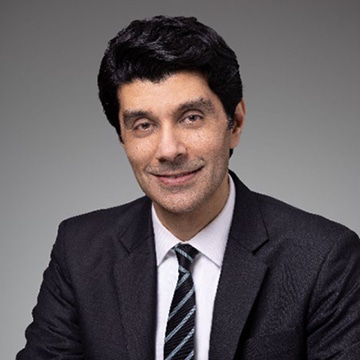 Raja’s journey began in Pakistan, where he was born and raised before moving to the United States for college. He attended Texas A&M University, after which his professional life took him and his family to Texas, California, New York, and even Latin America.
Raja’s journey began in Pakistan, where he was born and raised before moving to the United States for college. He attended Texas A&M University, after which his professional life took him and his family to Texas, California, New York, and even Latin America.
Currently a senior leader at Morgan Stanley, Raja is deeply involved in Environmental, Social, and Governance (ESG) initiatives. He explained, “ESG is about our practices around diversity and inclusion, our impact on climate, and our sustainability practices. It’s about being a good corporate citizen and making a positive impact on our employees, clients, and communities.”
Raja sees significant potential for applying these principles to CAI. “While ESG is often discussed in the context of corporations, it can also be relevant to nonprofits. At CAI, we can think about our footprint and our impact on the environment. This includes building schools in a sustainable way and considering our use of resources and waste management.”
In his daily work, Raja fosters an environment where team members feel comfortable expressing their ideas. “I believe in giving people the space to do their work and make mistakes. It’s the only way they learn and grow,” he said. In his view, a leader must be comfortable with sharing vulnerabilities, open to feedback, and willing to improve based upon it, which helps to create a culture of trust and open communication.
Raja’s decision to join CAI’s board was driven by a deep personal connection to the organization’s mission:
“I have an affinity for the Central Asia region because of my roots in Pakistan. This opportunity allows me to give back to a region that means so much to me. Additionally, when I think of my daughter who is 10, and the opportunities she has, and her love of reading, and everything she has accessible to her, and then I think there are probably so many children like her who do not have the same opportunities, and probably never will…this makes me excited to support CAI’s work in providing education to children who otherwise might not have the opportunity.”
By Marianne Monoc
A legacy in many ways symbolizes our life, values, and dreams. Whether we hope to be remembered as a caring parent, a trusted friend, a loving spouse, a concerned citizen, or even a philanthropist, we all wish to make a positive, and hopefully lasting impact on the world.
Many of our dedicated supporters have chosen to advance the values that are most important in their lives by providing a charitable gift to Central Asia Institute (CAI) through their estate plan.
Bonnie and Gary Chollet, long-time donors, share the reason they chose CAI for their planned giving.
“Our primary interest in our retirement is helping girls to get an education. The current situation in many countries in central Asia is dire for so many girls. We have been fortunate in our lives and use our RMD funds to help CAI. This organization uses its funds wisely, and we have been impressed by their work to help many girls. We feel so strongly about CAI that we have put the organization in our will.”
Regardless of the size of the gift, or how it’s made — via beneficiary designation, in a will or trust, or through a charitable gift annuity — you can provide funding to help support our mission and advance our work, as well as your personal charitable goals, for many years to come.
If you’ve ever read about our programs and thought, “I wish I could do more,” especially in today’s difficult economic times, you can! By leaving a planned gift to CAI in your will or trust (a gift that costs nothing up front), you can play a meaningful role in helping to achieve our vision of a world in which women and girls have the education and skills to unlock their full potential and contribute to a better, brighter future.
Over the years, you have made a significant difference by investing in CAI’s mission and the transformative power of education, changing lives and uplifting entire communities with your kindness. Make a legacy gift today, and ensure that your personal values continue to spread well beyond your lifetime.
For more information about how to designate CAI as a beneficiary of your estate, please contact us at info@centralasiainstitute.org or by calling 406.585.7841.
By Marianne Monoc
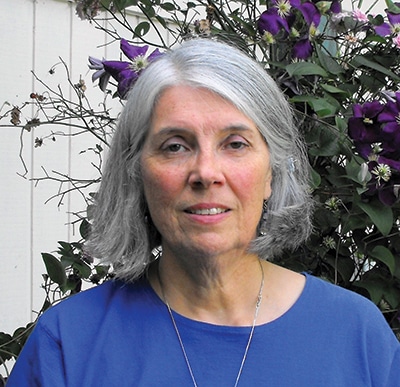
Marsha Williams first heard about CAI from her son, an avid mountaineer who had read a magazine article about CAI founder Greg Mortenson’s climbing adventures and the harsh, often unforgiving living conditions experienced by the communities he visited in his travels.
As a high school counselor for many years who was passionate about the field of education, Marsha was immediately drawn to the story and was touched by Greg’s inexhaustible determination to build a school in the region. A lover of exotic travel who is heading to Nepal this fall, Marsha had visited many Asian and Central Asian countries and felt drawn to assist in some way. On February 1, 2011, she became a CAI donor, and has generously supported our mission and programs since that day with a monthly sustaining gift.
A few years ago, Marsha began making an extra annual donation to CAI through her retirement account’s required minimum distribution (RMD). An RMD is the amount of money that individuals with pre-tax retirement accounts must withdraw from their accounts each year once they reach age 73. RMDs are designed as a government safeguard against people using a retirement account to avoid paying taxes. If you are over age 72 and elect not to take your RMD, you can be penalized by the IRS, with the amount not withdrawn subject to a 25% tax. Making a charitable contribution with your RMD can help you avoid tax liabilities, while at the same time supporting a cause that is close to your heart.
Marsha credits her decision to become more deeply engaged with charitable work to her sister’s husband, Dave, who passed away suddenly last year. Dave, an accountant, was helping her with some financial matters and asked her a couple of questions she had never considered before, “What is your philosophy of giving? What do you care a lot about?” That conversation made her really assess what was important to her and what kind of legacy she wanted to pass on to others. Her top interests and passions immediately rose to the surface: education, reproductive rights, environmental protection, and end-of-life care.
Marsha said that Dave’s question about her philosophy of giving changed her life and she is eager to share that experience with others:
“It caused me to reflect deeply, and I ask you to do the same. For me, I realized that I have plenty in my life and so giving of my own time, talent, or finances would not detract at all from my prosperity. I became much more thoughtful about my giving and increased it in support of the causes I care about. Those causes are going to vary from person to person, but I encourage you to ask yourself that same question and then discover where you can assist others in a way that is meaningful to you, whether big or small.”
Marsha has become an important member of our global community by continuing her monthly giving and helping fund special projects with her RMD. We are immensely grateful for her ongoing belief in our mission to advance education and livelihood skills for women and girls in Afghanistan, Pakistan, and Tajikistan.
Marsha’s story is an excellent example of how you can make an impact in multiple ways. Read on to find out more about CAI’s new donor recognition levels that make it easier than ever to support our work.

Make a Monthly Giving Commitment Today
CAI’s monthly sustainers automatically become members of our Base Camp Society.
In the world of mountain climbing, base camps are rudimentary campsites at the base of mountains used by mountain climbers during their ascent and descent. These areas are places of rest and safety, providing critical supplies and shelter. Similarly, CAI’s Base Camp donors provide the organization with regular and dependable monthly gifts that form the core of our support.
One of the most impactful ways to make a difference is through a monthly giving commitment. Your donation helps to strengthen and sustain the day-to-day work of CAI, enabling us to both plan for the future and react in real-time to circumstances that impact the communities we serve. Monthly gifts are also easy, convenient, and can be changed or cancelled at any time.

Mountaineers always seek the next challenge, often climbing technically difficult rock faces that require stamina and determination. Just like CAI’s donors, they are guided by the strength of their mission. We invite you to join CAI’s Mountaineer Society today.
By making an annual gift between $1,200 – $5,000, you will gain access to exclusive Mountaineer benefits, including:
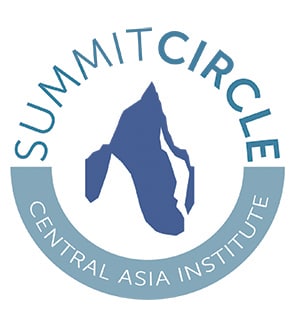
CAI’s Summit Circle recognizes the generosity of individuals and families contributing at the highest levels of personal giving. Summit Circle members affirm their deep level of commitment to CAI and its mission by contributing an annual gift of at least $5,000. As a Summit Circle member, you can establish yourself as a philanthropic leader, and pave the way in our mission to improve access to education, increase financial stability, and build vibrant and equitable communities in Afghanistan, Tajikistan, and Pakistan.
Join a network of like-minded charitable patrons dedicated to long-lasting, positive changes in our global community and enjoy the following benefits:
For more information about any of the levels discussed above, please contact the Development Team at info@centralasiainstitute.org.
By Lynzy Billing
High up in the Pamir mountains of eastern Tajikistan, 65-year-old Alimabonu Dovutova’s nimble fingers carefully thread her needle.
Dovutova lives with her husband, son, his wife and her two grandchildren in the village of Khidorjev in the Roshtqala district of Tajikistan’s Gorno-Badakhshan region.
She leads me into a small room in her home which she has converted into a sewing workshop. Each week, two other women join her here and together they sew and knit products to sell in markets in the regional capital, Khorog, and the country’s distant capital city, Dushanbe. Through their needlework these women support their families. “We started doing this work because most of our husbands are in migration, and no one but us will help us,” says Dovutova.
Tajikistan has a rich history of handicrafts which reflect the culture of the nation and are often made using traditional techniques and materials. Dovutova remembers her grandmother and mother knitting, “I watched and learned these handicrafts from them,” she says, turning her needle to an embroidered hat.
Dovutova turned the embroidery and sewing skills she learnt as a child into her own handicraft business selling her products in markets and to tourists traveling to Gorno Badakhshan.
In 2019, the President of the Republic of Tajikistan, Emomali Rahmon, announced a three-year plan to revive the country’s folk crafts, rural development, and tourism. In 2021, Dovutova took part in Central Asia Institute’s first Women’s Livelihood training, an initial ten-day intensive workshop designed to equip aspiring female entrepreneurs with the tools and knowledge to succeed in businesses such as baking, sewing, and weaving.
Dovutova credits CAI’s workshop with helping her to start her business:
“CAI helped me a lot with the development of my business. Before, I did not know how to sell my products, but after attending these courses I learned financial literacy and how to sell them at the market, how to find clients, and how to price the products to get a profit. After the CAI training,
I opened a small workshop, hired two more women and we started working. From the income we get, we buy more materials and all the time, we are developing the folk crafts that we create. Since I started my business, I have participated in different exhibitions and received many diplomas and awards. I am very happy with the work I have done.”
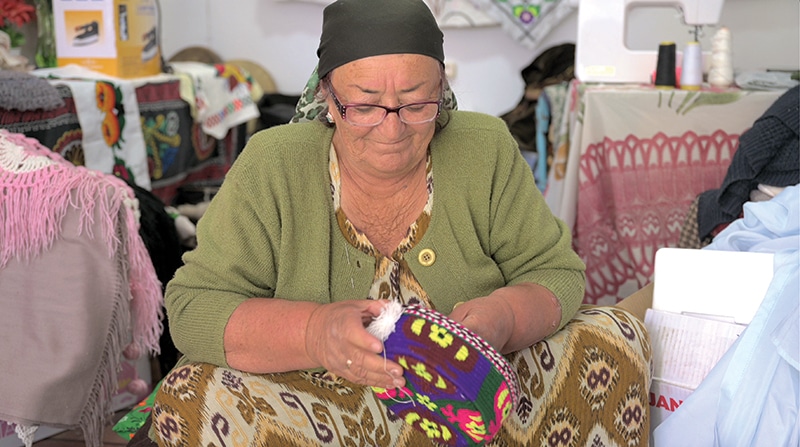
In the future, Dovutova hopes to hire more women to work in the workshop:
“The want is great. In 2023, I took another course at CAI and got more practice and knowledge. Now, a lot of young girls are learning from me. I teach them in courses and in the future, I would like to attract more young girls and women to work to develop this craft so that as many women as possible can get out of poverty through self-employment. Many other women are interested in developing small businesses like mine and they come to the shop and watch.”
Dovutova’s success has been an inspiration to other women in her village.
Launched in 2019, CAI’s ASPIRE program has trained over 350 women in financial literacy, setting up and managing small businesses, and marketing their products, among an array of other skills. This past year, CAI provided additional support to approximately 100 of the women who participated in the initial training to help ensure the sustainability of their nascent businesses. This included supporting them to develop a business plan with specialized training in certain sectors (food processing, garment making), and the provision of equipment. A similar training is planned for an additional 50 women in October 2024.
Since completing the training, several women like Dovutova have started their own small businesses which provide income to support their families while preserving the arts and crafts of their region. They have regular meetups in a group they established where they share business ideas and tips from their experiences of growing their own businesses. Several of the women have even received presidential grants to support their work.
To the south of Khorog, the narrow valleys are lined with apricot and cherry trees, with waterfalls cascading behind them. Below, in the string of verdant villages that look out over the valley, traditional Tajik bread called “naan” is being cooked.
Naan occupies a special place in the country’s cuisine. It is served at every meal and treated with the utmost respect. Here in the mountains, the culinary artistry of baking is deeply embedded in the community, and recipes are passed down for generations.
“Cooking has been my favorite thing to do since I was a kid,” says 49-year-old Zarafshon Yoqutkhonova. Today, she is making bread in Gojak village in Shugnan, a district which follows the foaming Panj river, along the border
between Tajikistan and Afghanistan, and where the ruins of an ancient Silk Road kingdom once flourished. She lives here with her three children who she is single-handedly supporting after her husband moved to Russia some years earlier.
High up in these mountains, the birds are her alarm clock. She wakes early and starts preparing the dough for the day ahead. “I always wanted to learn how to cook and during my childhood I learned from my mother and grandmother how to cook different delicious dishes,” Yoqutkhonova says. “Now with the help of technology I can bake even more delicious and beautiful dishes than they did.” Her baked goods are pieces or art, each one lovingly crafted and designed.
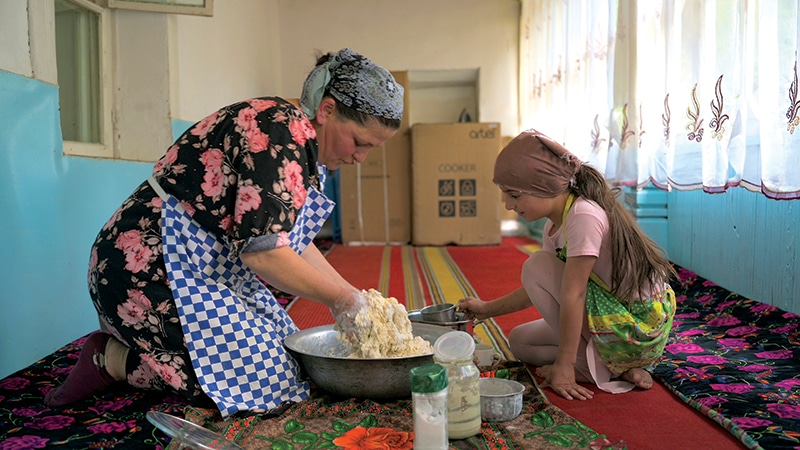
She kneels in her kitchen delicately stamping the raw dough before it is placed in the oven in her garden. Next to her, a stack of the round bread lovingly wrapped up awaits its journey along the dusty stretch of beaten road onto shops in the bustling city of Khorog. “Our village is small with few stores, so it was difficult to do business here so most of my bread and cakes are sold in Khorog,” she says.
Like Dovutova, Yoqutkhonova took part in CAI’s business training back in 2019. Her neighbor, 39-year-old Sofiya Suhrobova joins her in her kitchen. She also took part in the training and has since developed her own bakery business. She is a widow supporting one young child.
“In 2019, the Women’s Council of our village invited us for cooking courses. They were held for women who were at home and unemployed, but who can cook and make a business out of it. Then CAI invited us both for training,” says Dovutova. “Before, we cooked and mostly gave everything [away] for free. We didn’t even know how many grams of ingredients and products we use. But after the training we learnt how many grams of products we need in each cake, how to price them, and how to send our products to the city and other districts.”
Yoqutkhonova talks about her business with joy and pride:
“In 2023, after business plan training with CAI, I started selling more of my goods in my village, and I started receiving baked orders for more weddings and from the school. Last year, CAI gave Suhrobova and me a dough mixer and a new oven, and now I cook cakes in this oven, and in the big oven I cook cakes for weddings. I can provide flatbread and pies for 150 to 200 people. I went from being unemployed to starting my own business and supporting my children with their education.”
In recent years CAI Tajikistan (CAIT) shifted its focus from training to supporting these women in their entrepreneurship and business development objectives. The program envisioned by CAIT includes end-to-end support such as market assessments, specific skill training, and provision of raw materials and equipment. CAIT links them with financial institutions, networking opportunities, marketing products, and other knowledge and skills to help them better manage/operate their small businesses.
“My favorite thing is basket weaving,” says 61-year-old Turamoh Qadamalieva. Qadamalieva lives in the village of Namangut in the Ishkoshim district in the southwest of the Gorno Badakhshan region.
Like Dovutova and Yoqutkhonova, she learned the artisan craft from her mother when she was a child, just as her mother had learned from her mother before her.
Qadamalieva’s grandchildren live with her and they are learning the art of wea-ving. “In September and October, the reeds ripen and turn white,” explains Qadamalieva. “We collect them as reserves for the winter.”
“At home we clean them for one or two hours in clean water, and then begin to weave them,” says Qadamalieva with a smile, showing her granddaughter how to thread the long reed.
She started her basket weaving business in 2010 and regularly participates in festivals, showcasing an array of products from vases to bowls and taking
custom orders.
In 2019, the women’s committee of Ishkoshim district informed Qadamalieva that a two-week training was being held by CAI in Khorog.
She says she learned how to better run her business and manage her finances. She also met other female entrepreneurs, trading their tips and finding support in one another. “I’m very grateful to the trainers. We want there to be many more training sessions in the future,”
she says.
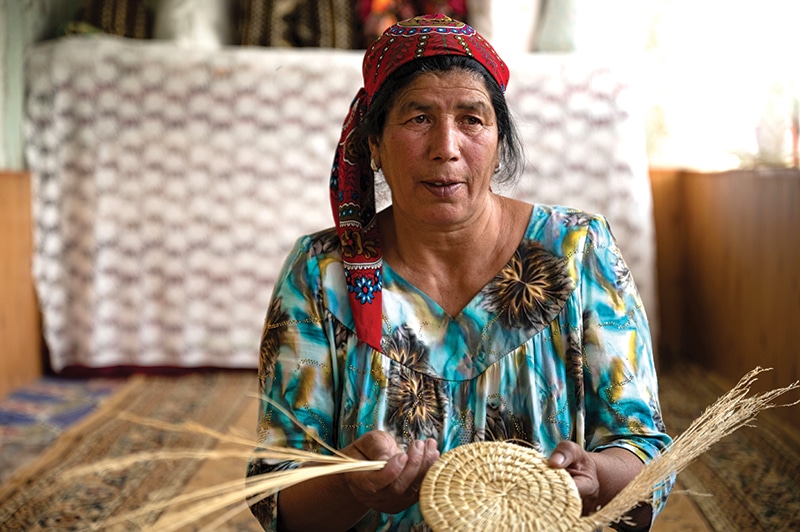
Since taking part in the trainings, Qadamalieva started teaching basket weaving to 15 other women in her small village so that they, too, can earn their own income.
Today, Dovutova, Yoqutkhonova, and Qadamalieva use their skills passed down from generations before them to continue the country’s cultural legacy and support their families. They hope their children will do the same. “My daughter and my nephews also bake with me,” says Yoqutkhonova. “We cook together, and we share ideas of how to develop our business together.”
With your support, CAI can continue to assist entrepreneurs like Dovutova, Yoqutkhonova, and Qadamalieva to develop thriving businesses that provide income, create jobs, revive folk crafts, and inspire other women in the community.
Next year, CAI plans to assess the ASPIRE program — now in its fourth year — to determine which businesses have been successful and identify what additional support might be needed to help them flourish and expand. Other women whose businesses have faced challenges will be provided with additional oversight and supervision to help develop their capacity.
Closing the gender gap is critical to global development.
By Alice Thomas
The countries of Central and South Asia face enormous challenges. While there are notable differences between Pakistan, Afghanistan, and Tajikistan, the countries where Central Asia Institute works, all suffer from high rates of poverty, unemployment (especially among youth), illness, disease, insecurity, and conflict. Add to these woes the worsening impact of climate change, as evident in more frequent and severe flooding, prolonged drought, growing food insecurity, and the spread of disease.
These countries also rank near the bottom of the World Economic Forum’s Global Gender Gap Index, which ranks 146 countries’ progress towards gender equality as measured across four key dimensions — economic participation and opportunity, educational attainment, health and survival, and political empowerment.i
With so many complex challenges, you might think that gender inequality must take its place in a long line of issues.
In rich and poor countries alike, however, the fight for women’s rights has far broader and deeper implications. It is a struggle that affects not just women all over the world (half the planet’s population), but all people. That is because closing the gender gap is critical to global development. For countries and their populations to thrive, more women need access to education, work, healthcare, and political representation. As the International Monetary Fund (IMF) explains, “Greater gender equality boosts economic growth and leads to better development outcomes. It contributes to reducing income inequality and boosting economic diversification and, in turn, supports economic resilience.”ii
The Girl Factor
That’s where the girl factor comes in. CAI’s theory of change has long been, “Educate a girl. Change the world.” It’s not just a catchy phrase. There is hard evidence behind these six words; evidence that the solutions to the greatest issues we face as humans require an educated female populace; evidence that has only continued to mount in the 28 years since CAI got its start in 1996.
CAI’s educational mission benefits males and females alike, and in the past two decades, countless girls, boys, women, and men living in marginalized, underserved communities have benefited from our programs. Yet in delivering education and jobs skills to these areas, our goal is not just to advance education for all. We also seek to capitalize on the transformative power of girls’ education
— a superpower that many countries (including the ones we serve) have yet to unleash, and without which they cannot overcome broader socio-economic problems.
Afghanistan and Pakistan have some of the highest per capita rates of out of school children in the world. In both countries, girls make up the majority of out of school children, especially in rural areas and at the secondary (high school) level. In Afghanistan, as of 2023, 80% of school-aged girls and young women (2.5 million females) were out of school.iii Of the estimated 22.8 million children who are out of school in Pakistan — the country with the second highest number of out of school children in the world — more than half are girls.iv While female enrollment is far better
in Tajikistan, dropout rates among girls are significantly
higher than boys, with 40% dropping out by 10th grade.v
In addition to unequal access to education, women in the regions we serve also lag significantly behind men in terms of workforce participation. In Pakistan, for example, only 25% of women work, far below countries with similar income levels. In Afghanistan, the Taliban’s ban on women’s rights to education and work has drastically reduced the already small percentage of employed women. At a time when Afghans are already suffering from soaring poverty and startling levels of food insecurity, the inability of women to contribute to their families’ income is worsening the suffering of all Afghans.
The potential of an educated girl is significant in so many other ways. Girls who receive an education are less likely to marry young and more likely to have healthier, more spread-out births.vi As mothers, educated girls have healthier families. There is even a growing body of evidence that one of the most effective strategies for combatting climate change is to educate girls.vii
CAI works to advance education for both girls and boys. Yet our emphasis on educating girls is not only to level the playing field between males and females in terms of literacy, employment, personal freedom, and opportunity. It is also to unlock the transformational power of an educated girl to bring about a better world for all.
iWorld Economic Forum, “Global Gender Gap 2024 Insight Report,” June 2024. https://www.weforum.org/publications/global-gender-gap-report-2024/
iiInternational Monetary Fund, “Pursuing Women’s Economic Empowerment,” 2018. https://www.imf.org/en/Publications/Policy-Papers/Issues/2018/05/31/pp053118pursuing-womens-economic-empowerment
iiiUNESCO, “Let Girls and Women in Afghanistan Learn,” 2023. https://www.unesco.org/en/articles/let-girls-and-women-afghanistan-learn
ivUNICEF, https://www.unicef.org/pakistan/education
vUNICEF, https://www.unicef.org/tajikistan/access-education
viWorld Bank Blogs, “Female Education and Childbearing: A Closer Look at the Data,” Elina Pradhan, 2015. https://blogs.worldbank.org/en/health/female-education-and-childbearing-closer-look-data.
viiBrookings, “Commentary: Why is Girls’ Education Important for Climate Action?” Christina Kwauk, 2021. https://www.brookings.edu/articles/why-is-girls-education-important-for-climate-action/
By Rida
Pakistan ranks 143rd out of 146 countries in achieving economic participation and opportunities for women in the 2024 Women’s Economic Gap Index.i This places Pakistan among the most challenging environments globally for women seeking economic empowerment. Despite comprising nearly half of Pakistan’s population at 48.76%, women are significantly underrepresented in the labor force, with only 25% actively engaged in economic activities. The situation is especially challenging for women in rural areas who lack the education and skills to access higher paid jobs.
Amidst these challenges, a significant transformation is underway in the apricot orchards of the remote, high-mountain region of Gilgit-Baltistan, Pakistan where Central Asia Institute has long worked. Despite women’s role in fruit harvesting, approximately 45% of the annual apricot harvest is lost due to insufficient agricultural education, inefficient preservation methods, and limited access to markets and training centers. Consequently, women face profound economic insecurity and lack of empowerment. To address these issues, CAI partnered with Moawin Foundation to launch the Women’s Fruit Dehydration program.
Through targeted training, nearly 100 participants from five districts in Gilgit-Baltistan were introduced to improved fruit processing techniques to enhance the quality of dried apricots — a staple of the national economy. As a result, traditional dehydration methods were modernized enabling women to dry fruit in just three to four days compared to the previous two to three weeks. According to Mr. Wahli, Moawin Foundation’s Regional Manager: “The introduction of modern techniques has been transformative for the village women. They now have access to efficient practices that allow them to preserve a greater portion of their harvest which helped them transition from merely subsisting on their produce to generating substantial income. This empowerment has given them greater control over their finances, enabling them to invest in their families’ health, education, and future. The program has also stimulated economic activity within the communities.”
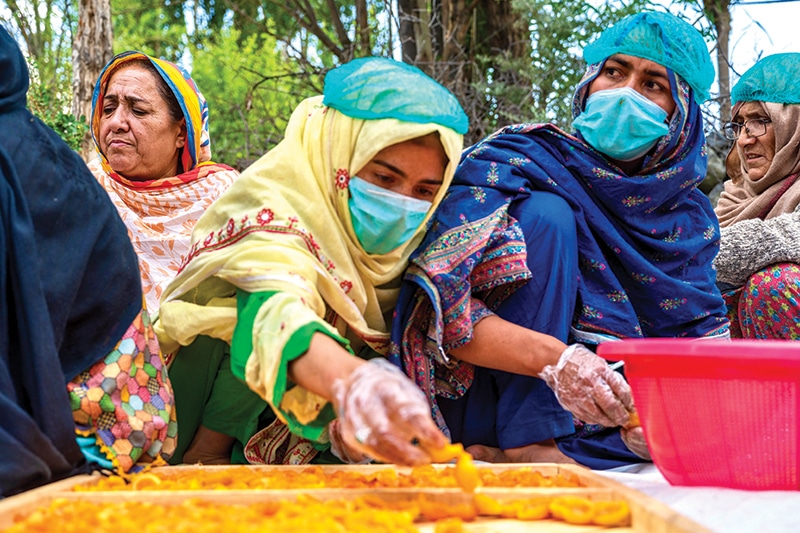
Before the program, a portion of the participants’ harvest went towards feeding families and cattle, while the remainder was discarded, resulting in both economic and environmental losses. Since its implementation, the program’s economic impact on women’s households is already promising to be transformative. Previously, these households earned approximately $70-$90 per month; now, they are projected to earn between $170-$220 per month — a potential income increase of up to 140%. Whereas their produce once sold for around 20 cents per kilogram, they now command prices between 82 cents to $1 per kilogram. This represents more than a 400% increase in profit.
Rashida, 43 years old and a single parent of three, used to depend solely on sporadic agricultural earnings. Her life changed when she joined the program. Equipped with new knowledge, she now dreams of expanding her operations to international markets. “Thank you to the donors for choosing a region where the common perception was that women couldn’t achieve much,” Rashida expressed gratefully. “Your support has shattered those misconceptions and empowered us to showcase our capabilities. Your investment has not only changed our lives but also inspired a new narrative of possibility for future generations. Thank you for believing in us.”
These women have not only brought financial prosperity to their households, but also discovered a sense of accomplishment. Faiza, 35 years old and from a family of eight with no formal education or prior work experience, shared, “What makes me incredibly happy is knowing that I am now recognized as a skilled individual. I no longer have to depend solely on my husband for every financial need. This independence gives me confidence and has empowered me to believe that I, too, can make a significant contribution.”
The success experienced by Rashida, Faiza, and other women participants has also changed their perspectives. Instead of envisioning a future devoid of opportunities, they now feel hopeful and excited about expanding their operations to new markets. Their achievements are also resonating beyond their immediate circle. As word of their success spreads, it has inspired women in other communities. “So many of my neighbors visit me to witness [fruit processing] demonstrations and express their eagerness to join the program. In the future, I want to become a trainer myself to empower other women,” said Rashida. This ripple effect is also impacting future generations. Children, especially girls, are witnessing their mothers break down gender stereotypes and become principal breadwinners.
All in all, it’s not just about the fruits they harvest; it’s about planting seeds of change for generations to come.
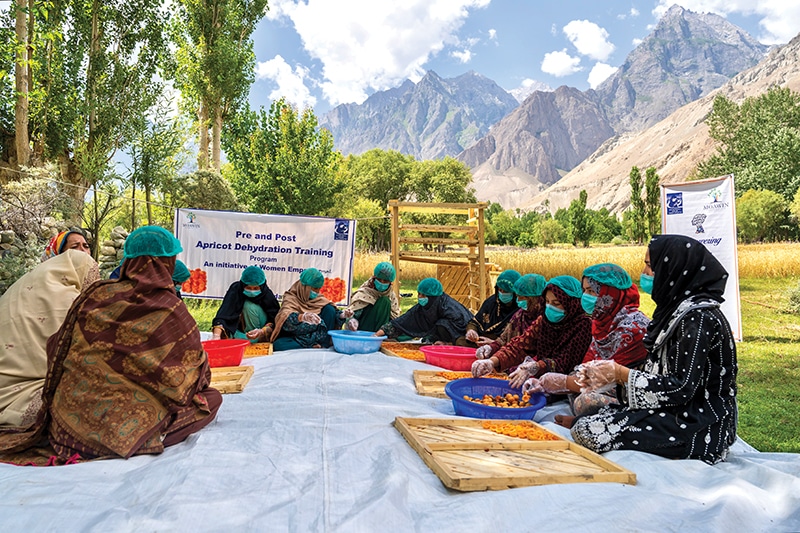
Rida is a Fulbright Scholar from Pakistan pursuing International Development Studies at Ohio University. She spent the summer of 2024 working as an intern with Central Asia Institute.
All photos in this articleprovided by Yawar Talib
iWorld Economic Forum, “Global Gender Gap 2024 Insight Report,” June 2024. https://www.weforum.org/publications/global-gender-gap-report-2024/
By Alice Thomas
One of the most common questions we get from our supporters is, “Is Central Asia Institute still working in Afghanistan?” The question is not surprising given that it seems the only news coming out of Afghanistan these days is grim.
Since taking control three years ago, the Taliban has imposed increasingly harsh restrictions on women’s rights to education, work, and freedom to move outside of their homes. Despite promises to rule justly, the group has resorted to its darkest ways, subjecting innocent women to imprisonment, torture, and even stoning. Adding to these woes is a soaring poverty rate and an anemic economy now that major donor countries like the U.S. have drastically cut back their support.
Many of you have written to ask how CAI is navigating this new reality. A recent email from one of our long-time donors, Jean K., echoes many of these questions and concerns. Jean writes, “I would love to have a sort of bulletin from you dealing with how you have had to change your programs to reflect the Taliban’s return to the power it had before the whole thing blew up.”
As we shared with Jean, thankfully, CAI has been able to overcome enormous challenges, and today provides education for Afghan boys and girls. At present, we support primary school education through Grade 6 with close to 8,000 children, including 5,388 girls, enrolled in CAI community primary schools. Our goal is to get as many children as possible, especially girls, to a level where they can read, write, and do basic math. With more than half of Afghan children out of school, we feel we cannot give up on this next generation of Afghan children. They are, after all, their country’s best hope for a better future.
At present, CAI community schools also provide training and salaries for 264 teachers, 192 of whom are women. Teachers have been especially grateful that we have continued our support given soaring poverty and unemployment rates.
We have, however, had to modify our programs. Tragically, the Taliban has not lifted its ban on education for older girls Grade 7 and above despite enormous pressure from the U.S. and other western governments. While initially we were reaching older girls in smaller groups through private tutors, the Taliban shut down those activities.
Currently, work opportunities for women also remain limited as the Taliban has prohibited women from going to office jobs or working outside the home. Even women’s beauty parlors were ordered closed. But women are still allowed to work in certain sectors including as teachers and medical professionals, and in industries such as agriculture and handicrafts like carpet weaving and sewing, as long as they are not working alongside men who aren’t their immediate family members. In addition to our ongoing support for female teachers, CAI is currently exploring how we might support older girls and women to work in these sectors. It is true that to work in these areas has risks. But at the end of day, what drives us is knowing that, despite the beliefs of the Taliban’s top leaders that females are mere chattels who should remain ignorant and locked up at home, the vast majority of Afghans, including in rural areas, support women’s education.
CAI has been working in Afghanistan for over two decades and even today, we cannot meet the demand for schools. In fact, it is the communities themselves that play a key role in setting up and managing our schools. This includes donating the space to hold classes and selecting members of the community to help manage the school. These School Management Committees (SMCs) receive training from CAI and are formally charged with helping to recruit teachers, ensure students attend, monitor student and teacher performance, and intervene when issues arise. For example, there have been instances in which local Talibs have tried to intimidate families into withdrawing their girls from school or shut down our schools altogether. In these cases, the communities themselves, through the SMCs, have pushed back. So far this has proven successful in every instance.
“The presence of a female teacher within our community has refreshed our hopes for the future and established a strong foundation that motivates us for further growth. Girls in our community are proficient in reading and writing and display enthusiasm for their future endeavors. Furthermore, community elders are mobilized and recognize the importance of girls’ education, actively advocating for it unlike before.” – Mrs. Ramela, a 30-year-old teacher in Mochekan, a remote and mountainous village in the Versaj District of Takhar province.
With so much human suffering around the world, it is easy to lose sight of Afghanistan. After all, the situation is complex and there are no easy answers. But Afghanistan is not a lost cause as many would dismiss it. Rather, in a world that is increasingly dominated by misogynistic ideologies that seek to silence women, Afghanistan is one of the most important battlegrounds for us to continue to fight and not walk away.
iResults of a 2019 survey by the Asia Foundation indicate strong public support for women’s education (86.6%) as well as women working outside the home (76%). “A Survey of the Afghan People – 2019,” https://reliefweb.int/report/afghanistan/survey-afghan-people-afghanistan-2019.
CAI sits down with M. Idrees Ghairat, Professional Specialist at the Afghanistan Policy Lab at Princeton University’s School of Public and International Affairs
The Taliban’s decision to ban females from secondary schools and universities has forced an estimated 1.5 million Afghan women and girls from school and had profound psycho-social impacts on their wellbeing. The Afghanistan Policy Lab at Princeton University’s School of Public and International Affairsi monitors the Taliban’s policies, delivers recommendations to governments and policy makers, and provides a platform for Afghan women to give input. The Lab also collects stories of Afghan teenage girls who have been banned from school. While heartbreaking, these stories reveal their courage, struggle, and resilience.
Aisha and Marwaii are two Afghan girls who took the risk of pretending to be boys to attend an English language course. Recalling the first day when they went for registration, they said, “We were scared, but we went to the school office and registered under the names of Ahmad and Mahmood. And we were seated in the boys’ class.”
In another story, Toba, who was teaching English at a language center, is now forced to stay home. But she and others like her have not given up. Using her smartphone, a laptop, and the Internet, she pursues learning online. “The only thing that encourages us to continue this struggle is the existence of these phones and computers and the Internet. If this space were not there, absolute darkness would rule in our lives,” she said. Muhammad Idrees Ghairat, Professional Specialist at the Lab explains that, “So far, engagements with the Taliban by the international community have not proved fruitful. Although a few Muslim scholars condemned the Taliban’s policies and have spoken out against the inhumane treatment of girls and women by the Taliban, these efforts have not been impactful.” He added that more work needs to be done, “There are a couple of ways Afghans together with the international community can work to continue the learning process to whatever extent they can, including supporting in-person and online education platforms for Afghan girls and women.” In addition to continued pressure by the international community, he sees an important role for religious leaders in Pakistan as well as Islamic scholars from the Middle East, particularly Qatar and Saudi Arabia, in influencing the Taliban to convince them of the importance of women’s education in Islam and provide examples of the role of educated girls and women in an Islamic Society. He believes that given the risks that women face, men should lead the debates and protests within the country to challenge the Taliban’s restrictive views on girls’ and women’s rights. “There is no other alternative but to convince the Taliban to lift the ban on girls’ education,” Ghairat insists.
He concludes, “An educated mother helps build an educated family, which leads to an educated society. With education, the economic situation of the household improves, leading to better living standards. Every step matters, and every initiative makes a difference. It is crucial that individuals worldwide support the education platforms to keep the learning process alive for Afghan girls.”
ihttps://spia.princeton.edu/spia-afghanistan-policy-lab
iiThe subjects’ names have been changed to protect their identities.